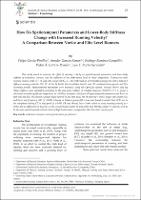Por favor, use este identificador para citar o enlazar este ítem:
https://repositorio.usj.es/handle/123456789/302
Registro completo de metadatos
| Campo DC | Valor | Lengua/Idioma |
|---|---|---|
| dc.contributor.author | García-Pinillos, Felipe | - |
| dc.contributor.author | García-Ramos, Amador | - |
| dc.contributor.author | Ramírez-Campillo, Rodrigo | - |
| dc.contributor.author | Latorre-Román, Pedro Á. | - |
| dc.contributor.author | Roche-Seruendo, Luis Enrique | - |
| dc.date.accessioned | 2020-01-16T14:42:01Z | - |
| dc.date.available | 2020-01-16T14:42:01Z | - |
| dc.date.issued | 2019-11-20 | - |
| dc.identifier.citation | García-Pinillos F, García-Ramos A, Ramírez-Campillo R, Latorre-Román PÁ, Roche-Seruendo LE. How Do Spatiotemporal Parameters and Lower-Body Stiffness Change with Increased Running Velocity? A Comparison Between Novice and Elite Level Runners. J Hum Kinet. 2019;70:25–38. Published 2019 Nov 30. doi:10.2478/hukin-2019-0036 | es_ES |
| dc.identifier.issn | 1899-7562 | es_ES |
| dc.identifier.uri | https://repositorio.usj.es/handle/123456789/302 | - |
| dc.description.abstract | This study aimed to examine the effect of running velocity on spatiotemporal parameters and lower-body stiffness of endurance runners, and the influence of the performance level on those adaptations. Twenty-two male runners (novice [NR], n = 12, and elite runners [ER], n = 10) performed an incremental running test with a total of 5 different running velocities (10, 12, 14, 16, 18 km/h). Each condition lasted 1 min (30 s acclimatization period, and 30 s recording period). Spatiotemporal parameters were measured using the OptoGait system. Vertical (Kvert) and leg (Kleg) stiffness were calculated according to the sine-wave method. A repeated measures ANOVA (2 x 5, group x velocities) revealed significant adaptations (p < 0.05) to increased velocity in all spatiotemporal parameters and Kvert in both NR and ER. ER showed a greater flight time (FT) and step angle (at 18 km/h) (p < 0.05), longer step length (SL) and lower step frequency (SF) (p < 0.05), whereas no between-group differences were found in contact time (CT) nor in the sub-phases during CT at any speed (p >= 0.05). ER also showed lower Kvert values at every running velocity (p < 0.05), and no differences in Kleg (p >= 0.05). In conclusion, lower SF and Kvert and, thereby, longer FT and SL, seem to be the main spatiotemporal characteristics of high-level runners compared to their low-level counterparts. | es_ES |
| dc.format.extent | 14 p. | es_ES |
| dc.format.mimetype | application/pdf | es_ES |
| dc.language.iso | eng | es_ES |
| dc.publisher | SCIENDO, DE GRUYTER POLAND SP Z O O, BOGUMILA ZUGA 32A STR, 01-811 WARSAW, POLAND | es_ES |
| dc.relation.requires | Adobe PDF | es_ES |
| dc.rights | Attribution-NonCommercial-NoDerivatives 4.0 Internacional | * |
| dc.rights.uri | http://creativecommons.org/licenses/by-nc-nd/4.0/ | * |
| dc.subject | Endurance runners | es_ES |
| dc.subject | Running kinematics | es_ES |
| dc.subject | Performance | es_ES |
| dc.title | How Do Spatiotemporal Parameters and Lower-Body Stiffness Change with Increased Running Velocity? A Comparison Between Novice and Elite Level Runners | es_ES |
| dc.type | info:eu-repo/semantics/article | es_ES |
| dc.subject.unesco | Lesión | es_ES |
| dc.relation.publisherversion | https://content.sciendo.com/view/journals/hukin/70/1/article-p25.xml?tab_body=Article | es_ES |
| dc.identifier.doi | https://doi.org/10.2478/hukin-2019-0036 Open access | es_ES |
| dc.rights.accessrights | info:eu-repo/semantics/openAccess | es_ES |
| Aparece en las colecciones: | Artículos de revistas | |
Ficheros en este ítem:
| Fichero | Descripción | Tamaño | Formato | |
|---|---|---|---|---|
| [18997562 - Journal of Human Kinetics] How Do Spatiotemporal Parameters and Lower-Body Stiffness Change with Increased Running Velocity_ A Comparison Between Novice and Elite Level Runners.pdf | 675,26 kB | Adobe PDF |  Visualizar/Abrir |
Este ítem está sujeto a una licencia Creative Commons Licencia Creative Commons

